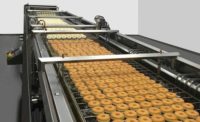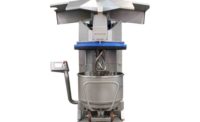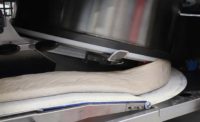Quick changeovers, smaller products, sanitation needs, oil quality and temperature control are all top-of-mind for customers of griddle and fryer equipment used for key snack and bakery applications, including doughnuts and frozen breakfast products like waffles and pancakes, as well as fried snack items, like chips.
Market demands
Moline Machinery, Duluth, MN, is “constantly asked” about providing the ability to make quick changeovers, says David Moline, vice president, sales and marketing. “Even though we are in a high-volume setting, quick changeovers are very important. Timing changes happen quickly. It’s a big deal when we’re going from a large to a small product.”
Moline has noticed a trend toward smaller products, especially on the yeast-raised side, such as mini doughnuts, honey buns or cinnamon rolls. “To accommodate that on the equipment side, we can adapt our frying conveyor systems to completely maximize the product density. We can have the same-sized fryer produce a much larger output.” This stands in contrast to other fryers, such as multipurpose fryers, where the operator has to size for the largest product, he notes.
Heat and Control Inc., Hayward, CA, has been responding to requests, especially from doughnut manufacturers, to fine-tune machines to guard against sediment buildup and provide for overall cleanability, says Doug Kozenski, sales manager, processing.
“I don’t want to say that the bakery industry wasn’t worried about sanitary design, but it wasn’t like the meat industry,” says Kozenski. “I’m seeing more and more interest in that—good design in manufacturing processes, minimizing points of harborage and good cleanability.
“There’s a lot of push to improve the work atmosphere, and oil quality,” adds Kozenski.
“Control of oil temperature and control of fryer speed are getting more and more important,” says Ken Weekes, international sales manager, WP Bakery Group USA, Shelton, CT.
Weekes also notes that everybody wants to do the smallest products possible, especially on the ring doughnut side, because it’s a unique product type.
Mike Niemczyk, sales & business development manager, TSA Griddle Systems, Carrollton, TX, says his company hears frequently about desires for ease of cleaning with no tools required, and easy changeover between product sizes.
New and improved
In recent months, TSA Griddle Systems has developed an improved bread loader and egg wash dipper for the efficient production of French toast, Niemczyk says. “The new designs allow the feeding of softer bread formulas and provide good control of egg wash absorption into the bread before cooking.”
TNA North America, Coppell, TX, has released the Florigo conti-pro 3, a continuous potato chip fryer using the company’s patented opti-flow technology, which optimizes oil flow through the kettle to help ensure each chip is evenly fried and reducing the amount of rejects in the product flow.
The opti-flow is based on an oil inlet section that alters the kettle’s fluid dynamics in a way that boosts oil flow speed and produces a smoother laminar flow over the fryer pan’s entire width and length. The technology minimizes turbulence, removing nearly all dead spots and preventing debris from settling, resulting in even frying of chips.
The Florigo conti-pro also offers such features as a product transport system with spring steel sealing, a touchscreen operating system designed for ease of navigation, an insulated hood with a collecting pan that can be lifted automatically, a frying kettle with rounded corners and a sloped bottom fitted with an internal clean-in-place system. It can also include a double heat exchanger that allows the operator to inject cooler oil toward the end of the process.
WP Bakery Group has rolled out the WP Kemper Largo, which contains updated technology mainly aimed at making it easier for the operator to have a system run for cleaning and better energy consumption, Weekes says. “We’ve reduced a lot of energy that needs to be used inside the line, through insulation and use of some oil.”
The WP Kemper Largo uses a turning ramp to lift doughnuts out of the oil to flip them over, which can be adjusted based on the size of the product, which Weekes says ensures that they are flipped correctly with a level of certainty that turning wheels, which flip the product 180°, do not provide. “That increases the security of running the line and ease of operation,” he says.
Secondly, the Largo fryer contains automatic systems for emptying oil after a run, with a flat bed and baskets that lift out so the operator can easily scrape debris off the bed. “A weekly cleaning can be done in an hour or an hour and a half,” Weekes says. “On top of that, the flow of oil is pumped throughout the system. We have a continuous flow of oil, it’s continuously filtered, and it’s kept fresh.”
Lastly, the WP Kemper Largo is so fully insulated to the point that a person can touch the sides or base while it’s running. “That reduces your costs on energy consumption,” says Weekes. “You can save about one-third of your energy used by doing that, with the thermal oil on top.” And, with recent software improvements, he adds, it’s easier for the operator to adjust. “You need to put in the product name and the oil level, and everything is automatically adjusted.”
Heat and Control has introduced several improvements to its Mastermatic line of doughnut fryers, Kozenski says. The most-significant difference is probably improved means of removing pieces and particulates from the line. “You have a fruit-filled cake doughnut, and little pieces fall off, or flour dusting from the yeast-raised doughnuts,” he says. “We utilize what we call sediment removal, a conveyor that drags the bottom of the fryer pan to remove anything that drops down.” One benefit of this approach is that the oil does not become carbonized from buildup.
Along with that feature, the Mastermatic offers continuous filtration of the oil. “We are constantly passing the oil through filtration of some sort,” Kozenski says. “There are several different styles that can be used, but we are typically circulating oil at 30 to 35 gallons per minute through filters, continuously cleaning the oil. That’s a big difference compared to previous doughnut fryers. Historically, we had to shovel pieces out of the bottom.”
The newer Mastermatic units have fully enclosed hoods that minimize smoke and odor, creating a better environment for employees, says Kozenski. And the Mastermatic now allows for automated clean-in-place sanitation.
Moline Machinery offers the LIBRA series of fryers for doughnuts and pies, which provide continuous sediment removal and continuous oil filtration. “The challenge with yeast-raised doughnuts, or with fritters where you’re introducing starch, flour or fruit inclusions, is you have to have a method of getting sediment out of the fryer during production, and you’re filtering oil in such a manner that you’re cleaning it and extending oil life, so that product quality is consistent for very long durations,” Moline says.
“The sediment removal and continuous oil filtration goes a long way toward sanitation,” says Moline. “Without that, you would introduce so much sediment that it would reach your heating elements, and you would have to shut down.” When the operator does have time to shut down, he adds, they can gain full access to the panel and wet-wash it with a hose, which takes a fraction of the time as fryers with a more-antiquated kettle design and older technology.
The LIBRA is designed for 24-7 industrial and wholesale bakers and ranges in length from 16 to 40 feet, although the majority of fryers that the company sells are at least 30 feet long, Moline says. “There’s a lot of unique challenges in that environment.”
Moline has upgraded the electrical system for its electrical fryers, which are becoming more standard than gas due to performance advantages, to use very low-watt density heating elements that provide a number of benefits, Moline says. “The heat distribution across the width and length is completely even,” he says. “We have the ability to include, in theory, as many zones of temperature control as we want. They’re much more flexible.”
To allow for quick changeover, the LIBRA’s fryer control systems are electronically synchronized and geared to proofing systems, Moline says. “Products are fried quickly and they are easily adjusted, so timing changes happen quickly.”






